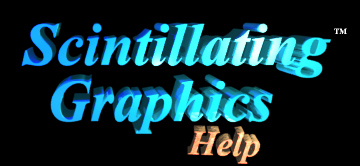|
|
 |
Many of our web pages include video and audio elements. We generally use the MPEG-4 format for videos, and MP3 for audio, with other formats as fallbacks (eg: WMV, MPEG-1, Real etc). For novices, there is a section at the bottom of this page which explains what MPEG-4 is, along with concepts such as plug-ins and streaming.
Each video we provide is usually available in a variety of different qualities ranging from near-DVD quality at the top-end down to low-but-tolerable quality for users with slow Internet links. The quality of the videos you will see is determined by automatically checking the speed of your Internet link. If you wish to override this here's a page allowing you to manually set your preferred video quality.
With regard to software, in some cases you may need to install additional software to add MPEG-4 playback capabilities to your system. The recommended plugins for each system are listed below...
 Windows |
 Macintosh |
 UNIX / Linux |
NOTE: These help pages assume you are running recent versions of your web
browser and operating system. Older versions may not have the same features.
 Microsoft Windows
Microsoft WindowsUnfortunately, Microsoft has (so far) elected not to support the full MPEG-4 (.mp4) standard in Windows Media Player, so at present MPEG-4 video files cannot be played out-of-the-box on Windows systems :-( Luckily, Windows Media Player does at least support Microsoft's mutant MPEG-4 variant (MS-MPG4, also known as MP4S or WMV1), which we provide as a fallback in many cases.
For proper MPEG-4 support on Windows we recommend installing QuickTime, which (starting with version 6) can play MPEG-4 video and audio with superb quality. QuickTime provides a powerful and well-designed plug-in which also supports many other file formats and codecs (Sorenson, QTVR, MP3 etc) and it fits seamlessly into the end-user's web browsing experience. You may also be interested to learn that the MPEG-4 file format is based on the QuickTime file format.
 Apple Macintosh
Apple MacintoshOn the Macintosh things are wonderful because of QuickTime, which is part of the operating system and (starting with version 6) can play MPEG-4 video and audio with superb quality. QuickTime provides a powerful and well-designed plug-in which also supports many other file formats and codecs (Sorenson, QTVR, MP3 etc) and it fits seamlessly into the end-user's web browsing experience. You may also be interested to learn that the MPEG-4 file format is based on the QuickTime file format.
NOTE: Although QuickTime is included as a standard part of MacOS, if your system is not up-to-date (at least MacOS 10.2 Jaguar) you may need to upgrade to version 6 as versions of QuickTime prior to 6.0 cannot play MPEG-4.
 UNIX (Linux, Solaris, IRIX, FreeBSD etc)
UNIX (Linux, Solaris, IRIX, FreeBSD etc)This information is currently being revised, sorry.
The HTML web page file format allows for much more than just simple text and pictures on a page. In fact, the combination of JavaScript, the EMBED tag, and other HTML extensions allow for a rich multimedia presentation to be delivered, including video and audio (sometimes called "rich media").
Just as with images, there are many ways to compress video and audio, resulting in many different file formats. Some of these formats only contain audio (MP3, WAV, AIFF, uLaw/AU, RealAudio), while others can contain both video and audio (MPEG, MOV, AVI, WMV, RealVideo/RealMedia). Some of these formats (MOV, AVI, WMV & Real) support several different types of compression (codecs) internally, such as Cinepak, Indeo, Sorenson etc - so (for example) not all MOV files are the compressed in the same way.
 We choose to provide our video elements primarily in MPEG-4 format (.mp4) and our audio in MP3 format (.mp3). MPEG-4 is the successor to the popular MPEG-1 and MPEG-2 video formats, which were used for VideoCD and DVD respectively. MP3 is widely used to distribute music on the Internet, and is actually an enhanced form of the audio compression used in MPEG-1 video files (which was called MP2). Just so you know, MP3 actually stands for "MPEG-1 Layer 3", not MPEG-3 (there was no MPEG-3).
We choose to provide our video elements primarily in MPEG-4 format (.mp4) and our audio in MP3 format (.mp3). MPEG-4 is the successor to the popular MPEG-1 and MPEG-2 video formats, which were used for VideoCD and DVD respectively. MP3 is widely used to distribute music on the Internet, and is actually an enhanced form of the audio compression used in MPEG-1 video files (which was called MP2). Just so you know, MP3 actually stands for "MPEG-1 Layer 3", not MPEG-3 (there was no MPEG-3).
MPEG-4 promises to revolutionize video on the Internet, making high quality video a mainstream part of the web, just as MP3 did for web audio and digital music. One reason for this is technical - MPEG-4 provides extreme compression (more than twice as good as MPEG-1) while still producing superb quality (nearly equal to MPEG-2, ie: DVD). This means less bandwidth is required than for older formats such as MPEG-1 or Sorenson, so you can provide reasonable-quality video in realtime on links as slow as 30-40 KB/sec, and near-DVD quality on faster links.
But another, even more important reason why MPEG-4 will revolutionize the web is political - MPEG-4 is a vendor-neutral standard, so it's not a proprietary format "owned" by any one particular company. This is crucial in gaining widespread acceptance and broad cross-platform compatibility (it was the reason BetaMax failed where VHS succeeded, for example). With the sole exception of Microsoft, virtually all of the major computing and consumer electronics companies have thrown their support behind the MPEG-4 standard, which means devices and software that all interoperate correctly (just like all web browsers can read JPEG pictures, for example).
Unlike static images, a user can be watching a video or listening to some audio while it is still downloading. That is, the video or audio can start playing while the file is downloading. Such "streaming" behavior (playback while downloading) works very smoothly, and means that the end user doesn't have to wait for the entire file to download before playing it. With such technology, the total size of the file is not so important, only the data rate, ie: the rate at which data must keep coming in to achieve smooth uninterrupted playback.
To avoid stop-start playback, smart plug-ins such as Apple's QuickTime usually measure the speed of the download and use this information, in combination with knowledge of the length of the file, to determine how much should be downloaded before playback should start so that playback ends just as the final bytes of the file are coming in.
Obviously, when the downloading speed is less than the video clip's data rate there will be an initial delay before streaming playback can begin. During this delay the plugin loads enough of the file so that once playback starts the rest of the file will download in roughly the same time as the file takes to play.
Some types of streaming continually re-negotiate the quality of the video and audio to compensate for the speed of your Internet link. That is, rather than delaying the initial playback they reduce the quality of the material (resolution, frame rate etc) until it is able to be played in realtime with no delay. Since this type of streaming often results in very low quality video, we do not use it.
Playing a high quality MPEG-4 video requires a reasonably fast computer (at least a Pentium-II, PowerMac G3 or similar). Playing while downloading (streaming) requires even more power, and scaling or zooming to full screen requires even more power again. Slower machines will drop frames and/or lose audio sync.
Streaming at high data rates requires a recent version of your browser and operating system. Bottlenecks in older OS versions mean they will often struggle to push the data up through the networking system, into the browser, and into the MPEG plugin fast enough.
Some Internet service providers use web caches which have problems with very large files such as video clips. If you find your downloading suddenly just stops, you may need to bypass your ISP's web cache by changing the proxy preferences in your web browser.
This document was last updated on
| Scintillating Graphics, the Scintillating Graphics logo and VRMLmagic are all either registered trademarks or trademarks of Scintillating Graphics. |